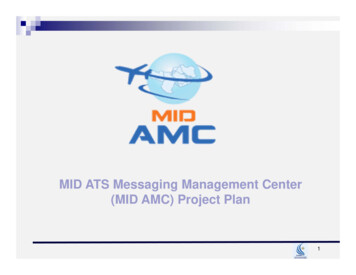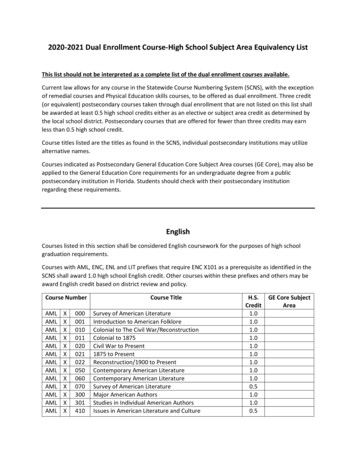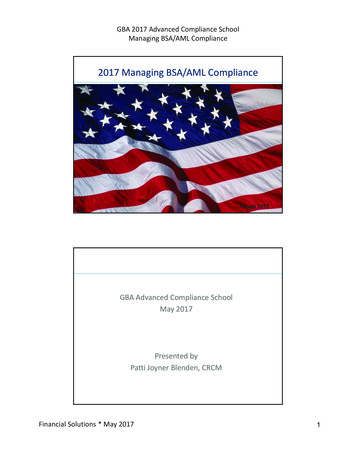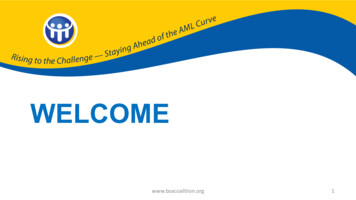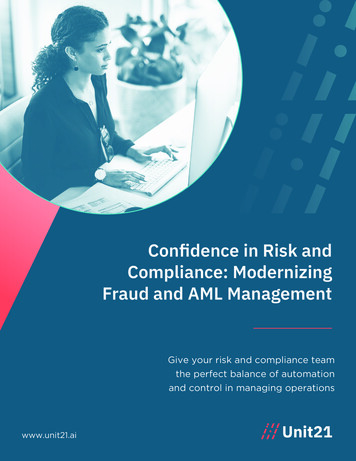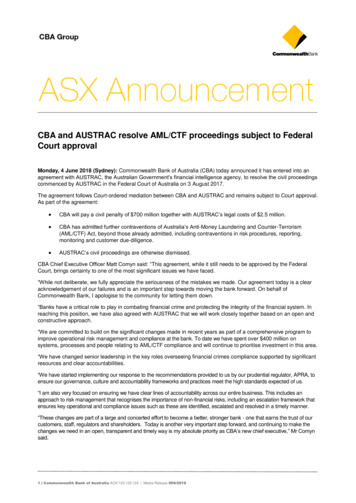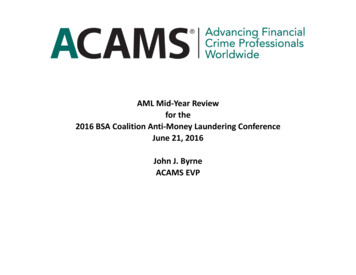
Transcription
AML Mid‐Year Reviewfor the2016 BSA Coalition Anti‐Money Laundering ConferenceJune 21, 2016John J. ByrneACAMS EVP
Key Issues/Challenges PanamaPapers/Shell Companies/CDD Enforcement Action Themes De‐risking and Financial Inclusion Expansion of BSA Coverage to Gaming, FinTech andOthers FATF and Direct Relationship to All Banks Human Trafficking, Terrorist Financing and ContinuingChallenges AML‐‐‐‐Time to Revisit Mission, Goals and Why2
AML Compliance Challenges Faced by OrganizationsIncreased regulatory expectations continue to represent the greatest AML compliance challenge, cited by 60% ofrespondents, followed by concerns regarding shortages of trained staff. Formal regulatory criticism is mentionedmore often in 2016 compared with 2015.Main Challenge (2016)Increased regulatory expectations & enforcement of currentregs53%Having enough properly trained AML staff36%Insufficient/outdated technology31%15%26%26%25%25%23%22%Understanding regs outside home country24%Sanctions complianceUnderstanding regulations in home country19%7%Additional regulationsLack of senior management/BoD AML engagement28%27%Budget constraints & increased scrutiny of 3rd party reviewsFear of personal civil & criminal liability41%38%36%32%31%Too many false positive screening resultsFormal regulatory 15%5%14%17%13%9%9%10%2%5%1%3
Panama Papers 11.5 million documents Panamanian Law Firm created 250,000 shell companies But really nothing new (e.g. NY condos, London housingmarket.) Tax evasion continues to thrive (need for ML predicate) Real hurdle is corporate formation FinCEN CDD Rule and the Creation of a Fifth Pillar We all have room to improve44
Enforcement Action ThemesActions impact small banks as well as large in areas suchas: Corporate governance Qualifications and training Prompt response processes to audit Performance appraisal for FI’s executives Risk rating of customer’s entire relationship with the FI Independent Testing improvement Internal controls55
Exiting Business Lines & Customer SegmentsIn 2016, 40% of respondents report their companies have exited a full business line or segment of business in thepast 12 months due to perceived regulatory risk and/or the organization's inability to manage the risk, an increasefrom 2015. About one-third of respondents claim their companies are planning to exit and/or are investigating thepossibility of exiting a business line or segment in the next 12 months due to regulatory risk.Possibility of Exiting Business Line/Segmentin Next 12 Months Due to Regulatory RiskHave Exited Business Line/Segment or CustomerSegment in Past 12 Months 12%33%Planning to exit10%Due only to regulatory risk201630%2016201523%Investigating possibility of exiting24%25%2015Due to inability to manage the risk21%67%Not planning or investigating exit70%Net: Have exited foreither reason2015201635%40%Net: Planning and/orinvestigating possibility ofexiting2015201630%33%6
Types of Business Segments & Reasons for ExitingMore than half of respondents whose companies are considering exiting business segments mention leavingindustries designated as high-risk by government agencies. At least 40% also cite leaving specific product lines orgeographic areas. The main reasons for leaving involve the organization no longer willing to assume the segmentrisk and the cost of compliance making the segment unprofitable.[Among Those Planning and/or Investigating Possibility of Exiting ]Types of Segments Considering Exiting2016 onlyIndustries that have beendesignated high-risk bygovernment agencies51%Specific products/product lines45%Specific geographic area(s)Non-Governmental Organizations(NGOs) or charities40%Reasons Considering Exiting SegmentSegment no longer withinorganization's risk appetite56%Cost of compliance makessegment unprofitable51%Segment draws excessiveregulatory oversight40%No confidence regulators willapprove risk managementapproach20%14%Segment is generally unprofitableOther18%8%Other1%7
Factors That Could Make Firm Re-Evaluate Exit DecisionMore than half of respondents whose companies are considering exiting business segments claim that betterguidance from regulators could keep them from leaving. However, over 20% believe nothing can influence thedecision to exit.[Among Those Planning and/or Investigating Possibility of Exiting ]2016 onlyMore precise guidance from regulators or increasedcompliance comfort for segments in question53%A mechanism to "pre-clear" compliance activitieswith regulator for riskier business segments32%A "hold harmless" letter or some type of “safeharbor” from regulators or other governmentagencyOtherNothing could influence the decision30%3%21%8
De-risking and Financial Inclusion Causes?Financial institutions exiting whole lines of business due to lack of profit potentialLack of clarity from regulators on what constitutes proper due diligence or riskmanagementFinancial institutions exiting account relationships with certain entities due toperceived inability to manage the risk associated with the account or pressure fromexaminersFinancial institutions performing a cost/benefit analysis factoring in revenue, risk andreputationSolutions?Incentives for financial institutions to retain certain accountsThird party validation or certificationCreation of “greenlists”Standard licensing regimeSafe harborStandard audit for affected entities99
Continuing ChallengesExpansion of BSA Coverageto Gaming, FinTech andOthers1010
FATF June Plenary Global response to terrorist financing. Delegates will discuss progress in implementing theconsolidated strategy agreed in February and the report on this to the G20 meeting in July. As partof this, delegates are expected to finalise a handbook on requesting freezing action from FATFcountries and risk indicators to help the private sector to detect terrorist financing.Transparency and beneficial ownership. Delegates will discuss proposals for action to improvecountries’ effective implementation of measures to improve access to beneficial ownershipinformation. The ‘Panama papers’ were a timely reminder of the scale of abuse of companies andtrusts for a range of illicit purposes. Improving transparency has become a global priority, andFATF will make proposals for improving implementation of the FATF standards to the G20 inOctober.Non-Profit Organisations. Delegates will discuss the FATF Standard concerning non-profitorganisations (Recommendation 8), to protect the sector from abuse and support its activities, inline with effective implementation of the FATF’s risk-based approach.The outcomes of the mutual evaluation reports of Austria, Canada and Singapore. Thesereports assess each country’s measures to combat money laundering and terrorist financing, andmake recommendations to further strengthen these measures. These reports are expected to bepublished within two months of the plenary meeting, subject to the discussion in Busan.1111
Human Trafficking Information and ActionsNearly 70% of respondents report their organizations have modified AML training and/or transaction monitoring toincorporate human trafficking and smuggling red flags and typologies (organizations typically have done both orneither). Nearly all respondents work in organizations that use information, usually multiple sources, to identifyhuman trafficking and smuggling activities.2016 onlyInformation Used to Identify Human Traffickingand Smuggling ActivitiesActions Taken to Incorporate Trafficking andSmuggling Red Flags and TypologiesFinCEN or other advisoriesHave modified AML training73%63%Government agenciesHave modified AML transactionmonitoringNeither of these68%Adverse media65%FATF reports64%58%31%69% did one or bothOtherNone6%5%95% useinformation12
Terrorism-Related Actions70% of respondents report their organizations have modified AML training and/or transaction monitoring to includered flags and typologies indicative of ISIS terrorist financing and recruitment (organizations typically have done bothor neither).2016 onlyActions Taken to Include AML Typologies and RedFlags Indicative of ISIS Terrorist Financing andRecruitmentHave modified AML training65%Have modified AML transactionmonitoring64%Neither of these30%70% did one or both13
Going Forward Continuing Commitment to Society Respond to Overstatements andUnderstatements (i.e.recent WSJ piece) Work together Law Enforcement is essential to ALLdebates Time to consider a change in laws,regulations and guidance?1414
Award‐Winning ACAMS Today15
Anatomy of a Banking ScandalThe Keystone Bank Failure--Harbinger of the 2008 Financial Crisisby US Capital Chapter Communications Chair Robert S. PasleyThe story behind one of the largest banking scandalsFirst National Bank of Keystone, named the most profitable community bank in thecountry for three to four years, grew from a 17 million bank to eventually a 1.1billion bank—all from fraudulent activity. In this book, Pasley explains how this wasmade possible for a small community bank in West Virginia and how bankexaminers realized something was wrong.Robert S. Pasley worked at the Office of the Comptroller of the Currency forthirty years, as an attorney, a senior attorney, and an assistant director of theEnforcement and Compliance Division. He is now an attorney and consultanthandling bank regulatory matters and anti-money laundering cases.Mr. Pasley may be reached for interviews by phone (703) 683-4346 or e-mailbob@pasleyconsulting.net.Ordering Information:To order a copy of Anatomy of a Banking Scandal, visitwww.transactionpub.com*eBook is available from eBook vendors worldwide.16
John J. Byrne, Esq., CAMSExecutive Vice PresidentEmail: jbyrne@acams.org@jbacams2011!17
2016 BSA Coalition Anti‐Money Laundering Conference June 21,2016 John J. Byrne ACAMS EVP. 2 . Main Challenge (2016) AML Compliance Challenges Faced by Organizations. 4 Panama Papers 11.5 million documents Panamanian Law Firm created 250,000 shell companies
